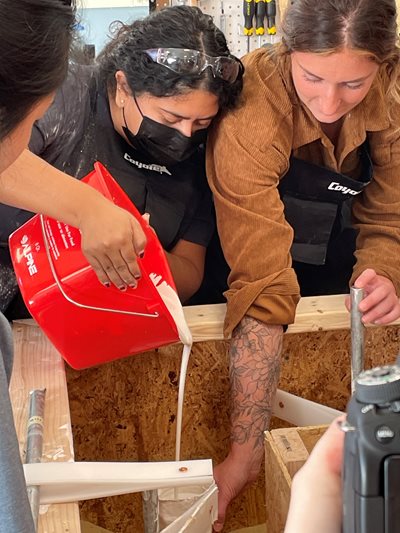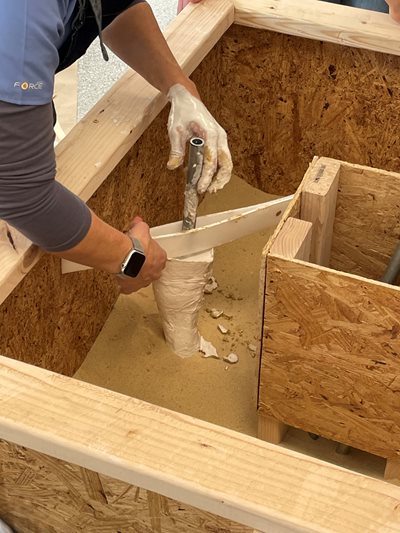Hearing the words “first pour” for the first time might initially conjure up images of an after-work happy hour at a local watering hole. But for students in the inaugural Orthotics and Prosthetics (O&P) cohort at Salus University, “first pour” means something completely different in an academic context.
 It’s actually the first time they receive instruction on and get to mix plaster and pour it into molds they will eventually use to design orthoses for their patients.
It’s actually the first time they receive instruction on and get to mix plaster and pour it into molds they will eventually use to design orthoses for their patients.
And, it turns out that “first pour” is a lot of fun, and sometimes quite messy.
“I was pretty confused at first. I wasn’t quite sure how ‘first pour’ was involved in O&P,” said Isabelle Mugnier ‘25OP, of Glenside, Pennsylvania. “I didn’t realize that we’d be working with plaster as much as we do. I learned that our lab is going to be messy a lot of the time.”
According to Julie Quinlan, MPO, MS, CPO, ATC, FAAOP, an O&P instructor, this first “first pour” for the students was part of the process for an upper limb project.
“It’s one of the steps in the fabrication process, followed by modification and then thermoforming, when we heat the plastic and vacuum-form it to the mold,” she said. “We then cut it out, smooth it and add strapping to finish the orthoses.”
With their aprons on, students gathered in the lab around a large, wooden box that contained sand. They mixed the plaster in a bucket on the floor which was covered in paper — well, most of it stayed in the bucket but shoes were definitely in the firing line — then poured the liquid into molds they had previously constructed of the forearm, wrist, and hand that they anchored in the sandbox.
 After a few hours of drying time, the students will modify them and then vacuum-form plastic over the molds. They will then remove the plastic from the mold, add straps and fit the orthosis to their patient models.
After a few hours of drying time, the students will modify them and then vacuum-form plastic over the molds. They will then remove the plastic from the mold, add straps and fit the orthosis to their patient models.
"The way we work is positive-negative, positive-negative,” said Virginia Muthard, CPO/L, FAAOP, an instructor in the O&P program. “We take the positive model — the patient initially — and take a negative impression, which is the plaster impressions. Then we pour liquid plaster into that to create another positive model so now we have a plaster positive model of the patient’s limb. In this case it was hands and arms. And, from there we create the negative orthoses, which is used to apply to the patient to create whatever effect we want.”
Muthard added that the “first pour” is one of the fun aspects to learning O&P. (There are others that are even more fun, she said.)
“Because all of this is so new, being able to have that more relaxed feeling going into it makes it much more fun and successful,” she said.
And, she felt that during the first-pour instruction. She said the students did a really good job and even though there are a lot of ways it can go wrong, the first-pour went pretty right.
 Nick Ruppenthal ‘25OP graduated from Brigham Young University/Idaho with a degree in exercise physiology. He wanted to do something on the rehabilitative side for his career, but wasn’t sure which direction he really wanted to go. Then he tore up his knee playing soccer and had to wear a knee orthosis. That process piqued his interest in the O&P profession.
Nick Ruppenthal ‘25OP graduated from Brigham Young University/Idaho with a degree in exercise physiology. He wanted to do something on the rehabilitative side for his career, but wasn’t sure which direction he really wanted to go. Then he tore up his knee playing soccer and had to wear a knee orthosis. That process piqued his interest in the O&P profession.
“I got a knee orthoses and I thought the process seemed really cool,” he said. “The O&P clinician took an impression of my knee and leg and I really wanted to learn more about it.”
Like the other O&P students, this was his first “first pour” too. “It was a lot of fun,” he said of the experience. “I really enjoyed mixing the plaster and using my hands. I love everything about this so far.”